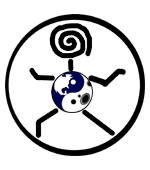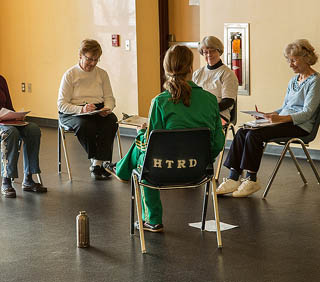 |

|
|
|
 | BENEFITS OF THE MAI PROGRAM |
|
Effectiveness Study of the Tai Chi 4 Health & Balance (MAI) ProgramSUMMARY The study was a self-assessment survey where participants ranked twenty-four separate measures of Health, Strength, Flexibility, Pain and Balance. The evidence conclusively supports the effectiveness of the Tai Chi 4 Health & Balance (MAI) program. Significant findings include high rates of pain reduction, high rates of improvement in health issues and strong rates of improvement in Balance, Strength and Flexibility. MEN DO BETTER There were 46 participants in the study. Four male participants and Forty-two Female participants. These results reflect observations on the male/female composition of the seniors class. The all age classes have more balanced composition. Male participants improved more than their female counterparts in all but one category. 50% of the male participants reported that attending with their wives was one of the reasons they came to the program. In six of the seven primary categories measured by the study there was less than 3.26% deviation between participants OVER 75 years old and participants UNDER 75 years old. The results indicate that the age of the participant does not significantly change the amount of benefit the participant can achieve. LONG TERM PARTICIPATION HELPS PAIN AND HEALTH CONCERNS The average number of years of participation was four (4) with the most commonly reported length of attendance (mode) being two (2) years. There was significant improvement in the Over 2 Years Participation (All Age) group over the average of the (All) group and the Under 2 Year Participation (All Age) group in the Pain and Other Health categories. This indicates that long term participation in the MAI program provides additional improvement in reducing pain and health concerns. MOST PEOPLE COME FOR BALANCE, HEALTH AND FUN Participants were given multiple choice responses to why they attend. Participants were allowed to make multiple selections. 95.65% of people came to improve their balance, 93.48% came to improve their health and 67.39% came for fun and social interaction. IMPROVEMENT IN MULTIPLE AREAS 100% of the people surveyed reported improvements in SEVEN or more of the 25 measured sub-areas. 78.26% of the people surveyed reported improvements in TWELVE or more of the sub-areas of the study. 67.39% of the people surveyed reported improvements in TWENTY or more of the sub-areas of the study. In the seven major categories the average improvement over all age brackets and all number of years participated is as follows:
OVER 20% IMPROVEMENT IN HEALTH, QUALITY OF LIFE AND ENERGY 93.48% of participants reported Health as one of the reasons for joining the MAI program. Participants reported a 22.26% improvement in Overall Health, a 21.54% improvement in Quality of Life and a 22.87% improvement in Energy Levels. 27.17% GAIN IN OVERALL BALANCE AND 25.93% MORE CONFIDENCE IN BALANCE 95.65% of participants reported balance as one of the reasons they attend the MAI program. Participants reported a 27.17% gain in their overall balance and a 25.93% gain in confidence of their balance. 19.05% IMPROVEMENT CLIMBING STAIRS, 24.62% IMPROVEMENT IN BACK STRENGTH One of the most common "Other Reason for Attending" write-in response was improving strength. Participants made between 19.05% to 24.62% improvement in the eight (8) measures of the strength category including a 19.05% improvement in climbing stairs, a 22.92% improvement in getting up from bed/chair/car and a 24.62% improvement in back strength. 23.64% IMPROVEMENT IN BACK FLEXIBILITY, 21.73% IMPROVEMENT IN SHOULDER FLEXIBILITY, 25.40% IMPROVEMENT REACHING OVERHEAD, 26.59% IMPROVEMENT BENDING TO THE GROUND. Back pain (36.95% of participants) and Shoulder pain (21.73% of participants) were the two most frequently reported pain types. Participants reported an improvement in flexibility in their back (23.64%) and legs (21.21%) aiding in a reduction of back pain by 43.14%. Participants reported an improvement in neck (25.79%) and shoulder (24.60%) flexibility aiding in a reduction of shoulder pain by 30.00%. Participants showed functional movement improvements in Reaching Overhead of 25.40% and an improvement of 26.59% in Bending to the Ground. IMPROVEMENTS IN BLOOD PRESSURE (24.03%) DIGESTION (25.00%), AND BLOOD SUGAR (33.33%) Participants reported an improvement in their blood pressure of 24.03% with 47.82% of participants reporting a problem with Blood Pressure. Participants reported improvement in their Blood Sugar regulation of 33.33% but only 17.39% of participants reported a problem with Blood Sugar/Diabetes. Participants reported an improvement of 25.00% in their digestive systems with 30.43% of participants reporting a problem. 30-61.11% REDUCTION IN PAIN Participants reduced their pain in the top reported categories by 30-61%. 36.95% of participants reported back pain and achieved an average pain reduction of 43.14%. Shoulders were the next most reported problem and participants reported improvement of 30.00%. Neck, Legs and Hands were the other top reported conditions with pain reductions of 42.59%, 33.33% and 41.67% respectively. THE MAI PROGRAM AND PHYSICAL THERAPY WORK TOGETHER 67.50% of participants responding have taken Physical Therapy. The most reported comments were "Physical Therapy got the process started but the MAI program took it further" with 35.00% of respondents making the comment and "The MAI program was a helpful addition to the Physical Therapy process" with 30.00% of respondents making the comment. Other comments included "Noticed crossover exercises" with 10.00% making the comment, "The MAI program was more enjoyable" with 7.50% making the comment, "The MAI program helped more" with 5.00% making the comment and "Physical Therapy worked one area, the MAI program was more comprehensive" with 5.00% making the comment. EXPLAIN IT The most frequent comment about the MAI program was that the participants liked having the exercises and their benefits explained. Explanations and Understanding is a key element of the MAI program and from the comments is one of the more enjoyed aspects. CONCLUSION The evidence obtained in this study proves conclusively that the Tai Chi 4 Health & Balance (MAI) program is effective. The main reasons people give for attending are health, balance and fun/social interaction. The Tai Chi 4 Health & Balance (MAI) program was effective across all the sub-areas measured. It was most effective in Pain reduction, Health Issues and Balance categories.
|
